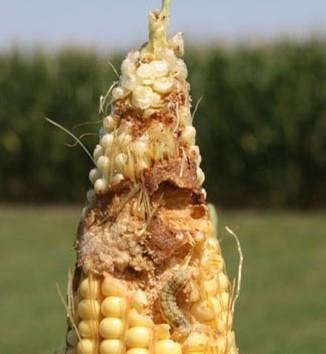By Anthony Zukoff
Anyone who grows corn is familiar with the variety of pests that attack the crop. One group of pests includes various “worms” that feed on developing corn ears (Figure 1). Corn earworm, fall armyworm, and western bean cutworm all can impact yield by consuming individual kernels. The damaged ears are then exposed to secondary fungal pathogens that can amplify losses. For quite some time, these ear-feeding pests have been well controlled through the use of Bt corn varieties. Unfortunately, in some corn growing regions of the country, these pests have become resistant to a majority of the commercially available Bt traits that have been used to control them. This has resulted in reduced efficacy of these traits and, in some cases, complete control failures. Reasons for the appearance of resistance in these pests have been identified and include:
- The use of the same Bt hybrid year after year; rotation to a new Bt package each season is just as important as rotating modes of action when applying foliar insecticides. The presence of single-trait Bt hybrids in a landscape of pyramided Bt hybrids has also been shown to reduce the durability of the pyramided hybrids if traits are shared between them.
- Poor refuge compliance is also a contributing factor as lack of compliance can increase the likelihood of local resistance development.
- In regions that grow corn and cotton in the same landscape, another scenario driving resistance is the presence of the same Bt traits in two different crops during one growing season. Corn and cotton share several traits that control ear-feeding pests and in some areas these pests are being exposed to the same Bt traits all season long, speeding up the development of resistance.
- Another contributing factor involves the use of seed blends, also known as refuge-in-a-bag (RIB). Cross pollination between Bt plants and non-Bt plants in the same field can result in ears that have weakened expression of Bt toxins, exposing pests to non-lethal doses that eventually fuel the development of resistance.

Figure 1. Corn ear damage. Photo by Anthony Zukoff, K-State Research and Extension.
In light of these challenges and the continued spread of resistance in the country, the US Environmental Protection Agency (EPA) has proposed some new rules regarding the use of Bt targeting these caterpillar pests. Some of the proposed changes, introduced in November 2021, are included below.
- Faster detection of potential resistance issues will be achieved through monitoring for unexpected injury (UXI) that exceeds pre-determined levels. Sentinel plots will be established in high risk areas of the country and monitored for UXI. If detected, various mitigation steps will be triggered.
- Refuge-in-a-bag (RIB) will be increased from 5% to 10% in pyramided Bt products nationwide.
- Single trait Bt products will be phased down over 3 years in the corn belt, 2 years in the cotton belt.
- Pyramided Bt corn products will not be phased down. Pyramids containing the Vip3A trait will maintain a 5-year registration time, while pyramids without Vip3A will have a shortened 3-year registration time.
- Enhanced refuge compliance monitoring will be implemented in the cotton belt.
These proposed changes are the product of several years of feedback from growers, industry, and university scientists from multiple states. The proposal is currently in negotiation with the seed industry and nothing has yet to be implemented.
Source : ksu.edu